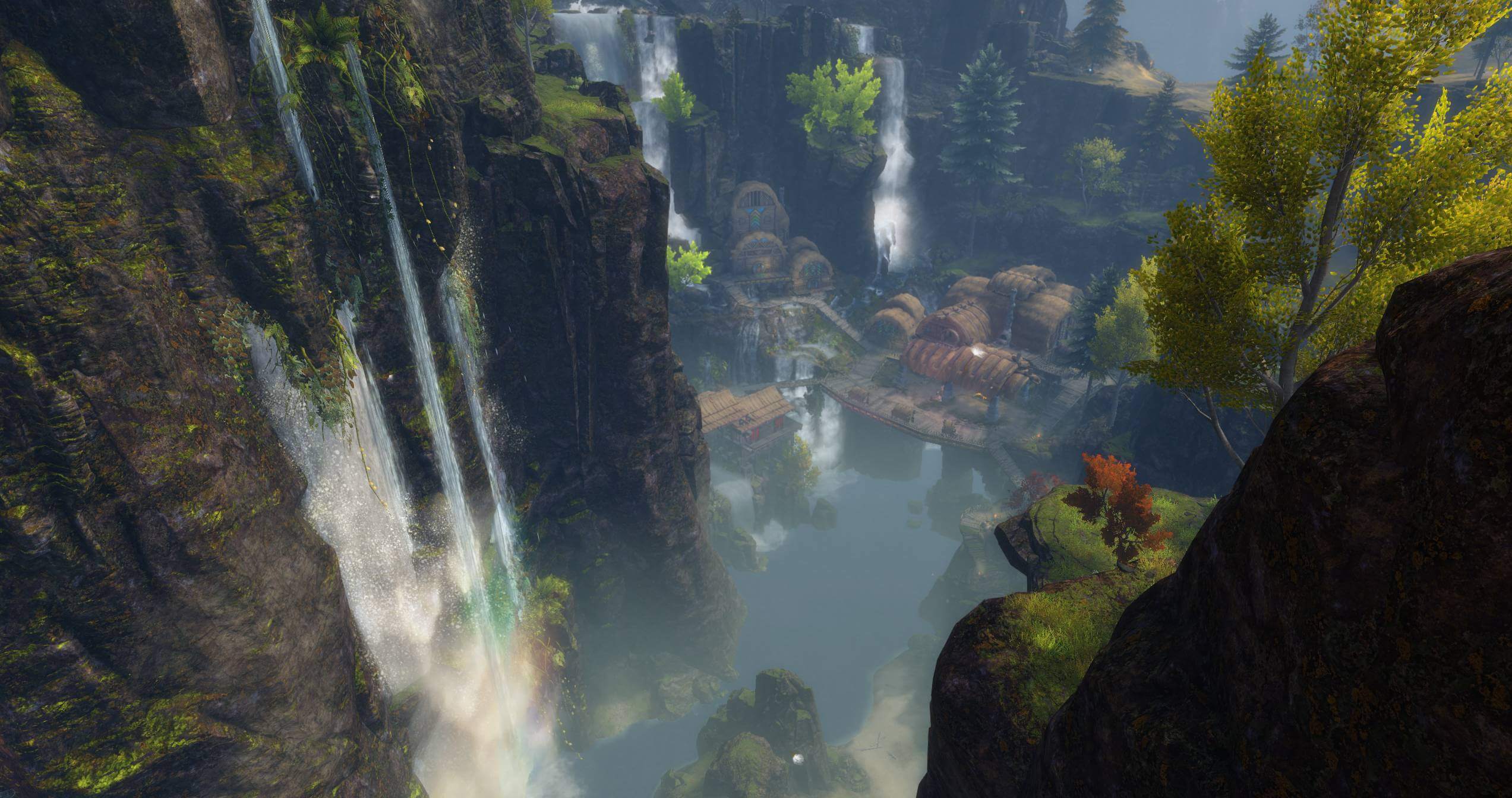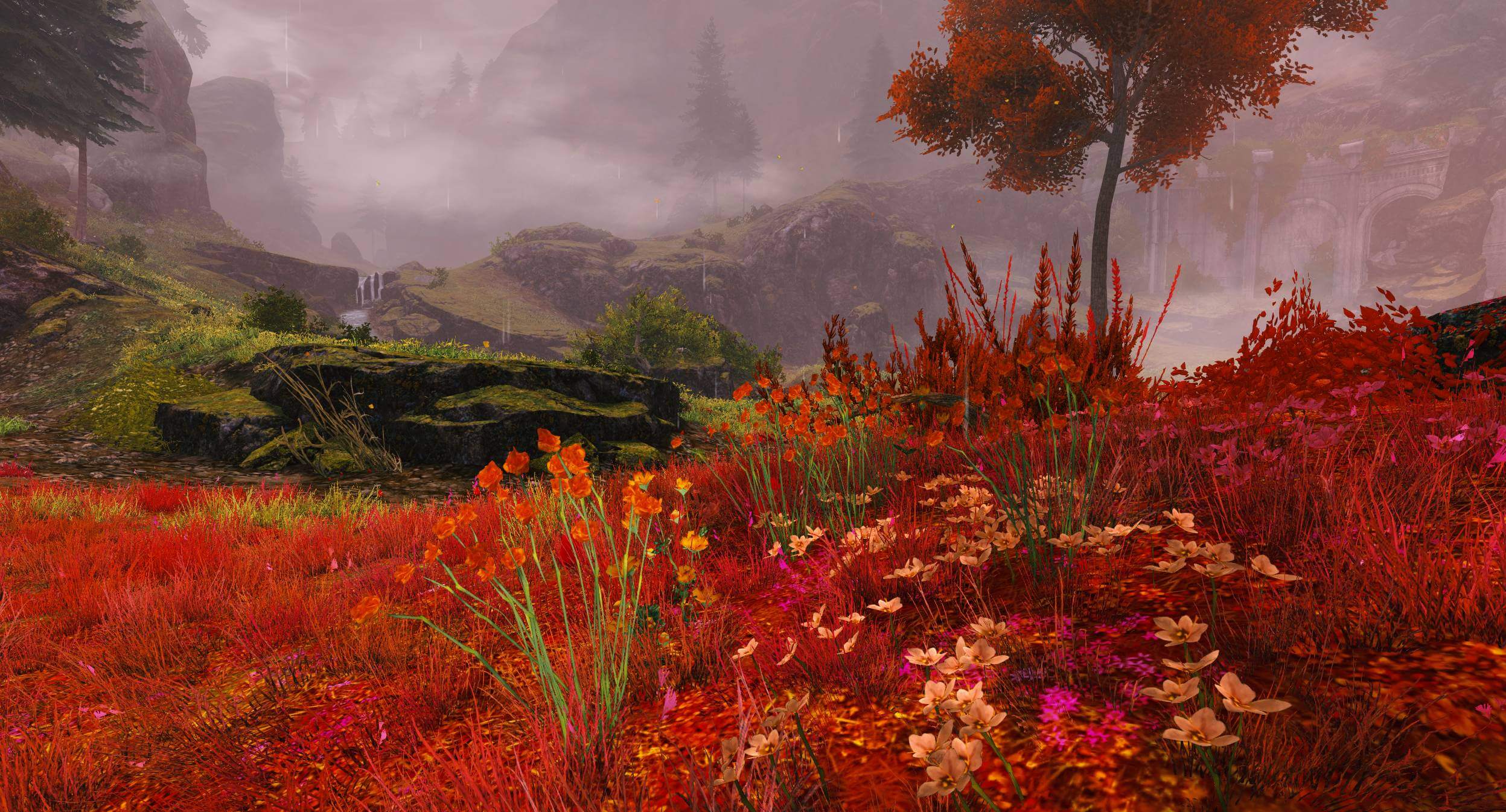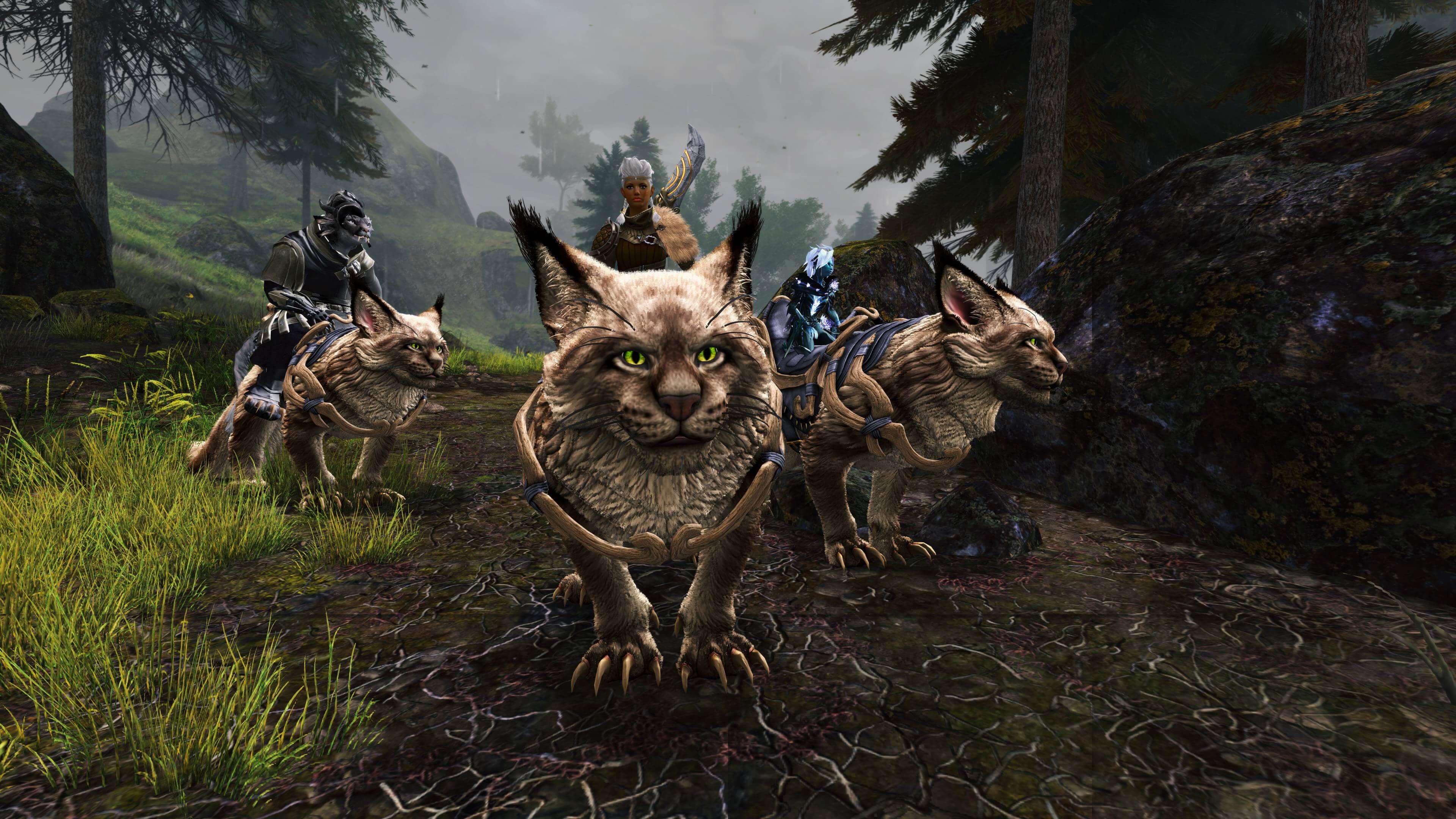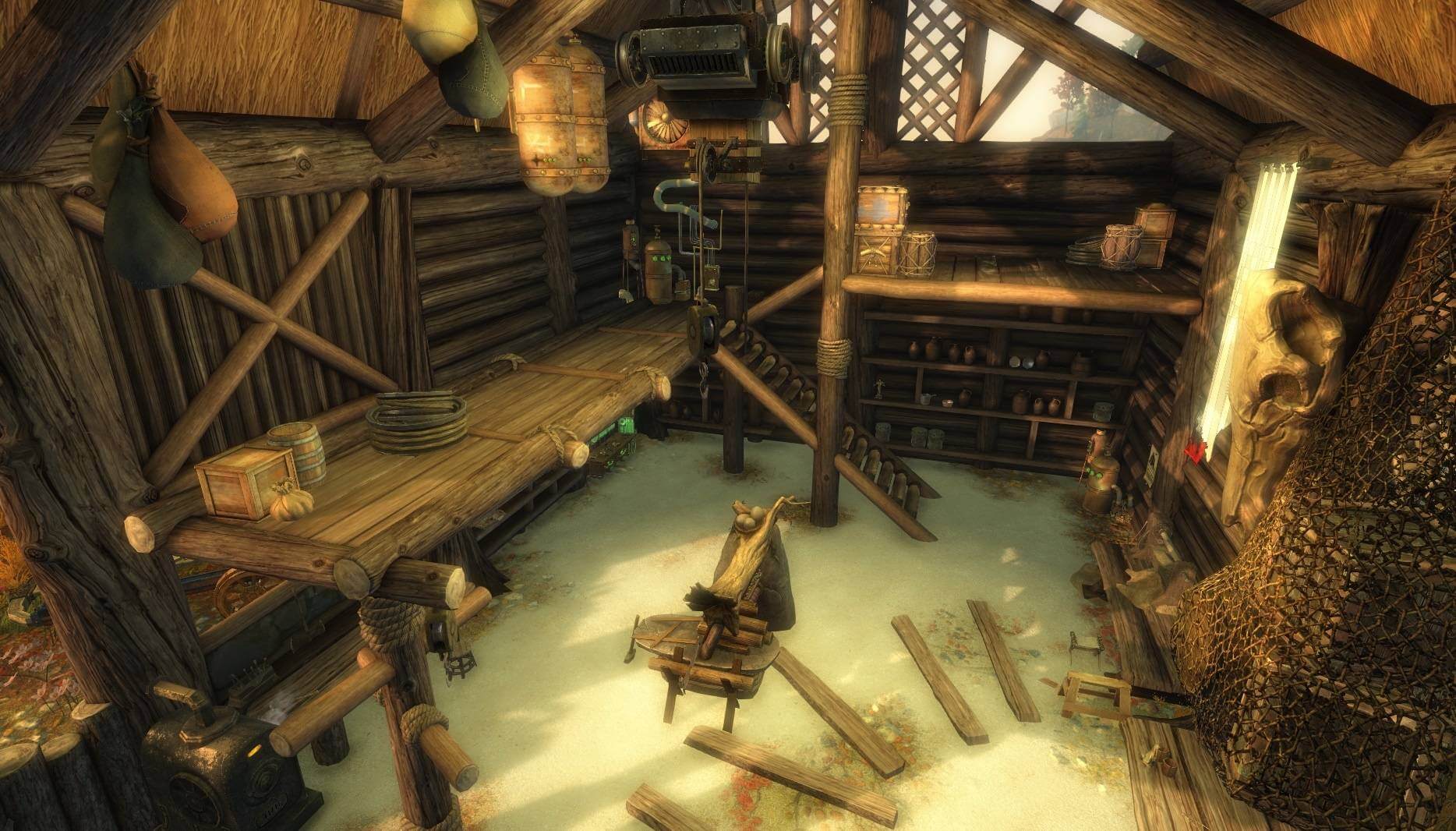Dopo la retrospettiva su Secrets of the Obscure e l’annuncio a inizio giugno di Janthir Wilds, la quinta espansione di Guild Wars 2 in uscita il 20 agosto, nella community del titolo si è riacceso l’entusiasmo. La curiosità è molta per l’arrivo di diversi contenuti tra cui una nuova storia, un raid e la possibilità di usare la lancia a terra, ma soprattutto per l’introduzione di Homestead, il nuovo sistema di housing che è stato descritto dai nostri colleghi di PC Gamer.
Visto l’avvicinarsi della nuova espansione nei giorni scorsi abbiamo avuto il piacere di fare alcune domande ad ArenaNet, in esclusiva italiana, sul nuovo ciclo di espansioni annuali, sull’esperienza avuta con SotO e sulle caratteristiche di Janthir Wilds, già disponibile alla prevendita sul sito ufficiale.
Di seguito potete leggere l’intervista, prima in lingua originale e poi tradotta da noi in italiano. A rispondere alle nostre domande sono stati il design lead di Janthir Wilds Andrew Gray e il technical director Ben Newell. Iniziamo!
Q&A with ArenaNet – Let’s talk about Guild Wars 2: Janthir Wilds
The annual development of expansions represents a major change from the past, and we think it has been a big challenge for the whole ArenaNet team that despite mistakes described in the SotO retrospective, has achieved good results. Compared to the Living World system and multi-year expansions, what are the positives that you think you left behind?
Andrew Gray, Design Lead: I’d say the biggest thing we lost was experience – we have years of experience making Living World seasons and our old multi-year expansion model so when we set out to adjust to the annual expansion model, we had to relearn a lot of things like reasonable scope, complexity of story, and some of the more challenging logistics like production plans and VO pipelines. Luckily we learned a ton working on SotO that we’ve already applied to Janthir Wilds so we’re already feeling back in the grove of things.
In SotO we saw the return of many ancient races, and with Janthir Wilds we will see the Titans again. This has renewed a strong interest in past events leading part of the community to replay Guild Wars 1, to delve into the events that happened before today’s. What is the idea behind choosing to have the world of Guild Wars 1 interact more concretely in Guild Wars 2? Is there a risk of repeating what happened with Soto: “a plot too complex for what can be reasonably handled within an annual expansion”?
Andrew Gray, Design Lead: The Wizards, predating Guild Wars by quite a long time, feel like a logical bridge to weave more of those threads from the original game – and possibly even earlier than that – into Guild Wars 2. That’s the “in world” answer, the development answer is some of us old timers have been around long enough to have worked on Guild Wars, some as far back as Prophecies, while others – and it makes me feel really dang old saying this – grew up playing Guild Wars, so with the dragon cycle arc finally complete, there was a lot of desire to go back to some original Guild Wars lore.
As to avoiding making a plot too complex to reasonable handle, that’s a great call out and has been at the forefront of our minds while developing Janthir Wilds. It’s challenging to dig into specifics without spoilers, but I know “trust me, bro!” isn’t exactly a satisfying answer so I will at least say that the bulk of the story is grounded in a regional threat in Janthir rather than a global threat or, in the case of SotO, a trans-planetary battle. The Kryptis caught the Astral Ward off guard and so that ratcheted the threat level to 11 right off the bat, and now the Astral Ward is focused on preventing the next calamity rather than responding to it.
Guild Wars 2 with its incredible art direction 12 years later is still a pillar of the MMORPG genre, but in other aspects age is showing. A lot has been done over the years with DirectX and the introduction of many quality of life, but there are parts of the game that seem obsolete. What aspects do you think need restructuring and what would you like to work on in the future?
Ben Newell, Technical Director: We’re constantly identifying aspects of the game to enhance with quality-of-life updates. For instance, we believe we can improve Guild Hall decorations by making the interface for placing them more intuitive and powerful, allowing players to fully express their creativity.
The upgrade to a newer version of DirectX has unlocked many possibilities for us. We’re exploring these opportunities by prototyping and testing new shadow technology, lighting improvements, and advanced water, to name a few examples.
The Convergences introduced by SotO positively surprised the community: reminded us of the famous raids of the past from different MMORPGs and made for large numbers of participants. Unfortunately, over time in the genre we saw a tendency to focus on content for fewer and fewer players.
Guild Wars 2 on the contrary continued to believe in them. What were your reasons for betting on this type of content? With the addition of the Titans to Convergence can we hope that will continue their development like other endgame content such as Fractals, Raids and Strike Missions?
Andrew Gray, Design Lead: We see Convergences going forward as a great way to give players an open world experience that mirrors Raid content, obviously with significant changes to make it appropriate as an open world fight. Raids are great, but far fewer people engage with them than open world content for a variety of reasons.
We want to make raids for the people who enjoy raiding so rather than trying to change raids to attract more of those players, so we see Convergences as a means to let more players experience the story, environment, and an open world version of the raid encounters, but in a 50-person squad (or public group) rather than a 10-person squad. I would expect us to at least strongly consider adding a 50-person Convergence version of raids when we release raids going forward.
Seeing the Warclaw “out of the Mists” was a big hit and we’re sure it brought a smile to those PvE players who have always feared entering WvW to redeem it. Thanks to this choice there will be another way to redeem and use its new abilities. Can you give us some more details about the Warclaw’s new skills, such as double jump, and tell us why are so important in the exploration of Janthir?
Andrew Gray, Design Lead: So there will be more info coming out on the Warclaw in coming weeks so I don’t want to spoil those reveals too much, but I will say Air Jump – which is what we’re calling it now since Double-Jump undersells the mechanic – makes navigating Janthir feel absolutely great.
The region is not flat, to say the least, with many sheer cliffs and valleys that make you think “Man I wish I didn’t have to go around the long way…” And the Warclaw delivers ways to get around the maps that I think players are going to really enjoy. We didn’t stop there! We found interesting ways to incorporate the existing WvW chain pull, spear throw and sniff abilities within the content in Janthir. Again, more details to come on that.
Housing has been one of the biggest revelations of Janthir Wilds: the community that has been asking for it for years is overjoyed because they thought this mode could not be implemented due to some technical limitations. What were the challenges encountered in introducing this new feature?
Andrew Gray, Design Lead: So the biggest hurdle when you sit down to start on an ambitious feature can often be yourself, specifically, one’s ability to overwhelm oneself with everything something could be. I think that has made player housing seem like a non-starter for quite some time in many people’s eyes because it’s a feature that’s going to have a lot of moving parts and can easily bloat into something out of scope – especially on an annual cadence like we are now.
I’m going to warn you this is going to be some possibly boring “how the sausage is made” details, but when we sat down to make Homesteads we broke everything down to what we call the “MVP” – Minimum Viable Product – and Stretch Goals. The MVP is the foundation of the system that, even if we weren’t able to add anything else to it, we could rationalize it as a strong enough benefit to players to be worth shipping. From there we took everything else – all the nice to haves, quality-of-life improvements, cute little details, etc. – and listed them out as stretch goals, and then prioritized those goals based on a cost/benefit ratio, or “how hard will it be to make” vs “how much does this benefit the players.”
With this information in mind and the foundations of the system in a solid place we were able to add nearly all of our stretch goals, and I attribute that to that “build up” approach to design on Homesteads that added features incrementally as-needed rather than starting with a grand design that throws everything and the kitchen sink at the feature on day one. Though, technically, there is a kitchen sink…
Speaking of the foundation of Homesteads, the guild hall decorating system was used as half of that foundation, with the functionality of the home instance – resource nodes, boards, and of course the many stray cat’s you’ve adopted over the years – making up the second half. Homestead decorating is a separate crafting discipline than Scribing, but the decoration options in guild halls will appear in Homesteads over the course of the expansion’s future releases and festivals.
We made some really great improvements to the decorating system and a ton of other exciting features that we’ll be sharing more about later this month, but for now I can say a lot of the wish list items players are speculating about are, in fact, included in the feature either at launch or in one of the content releases.
There has been a lot of talk about new additions to the title in the past years, and one of those was the Jewelcrafting level 500. Is it still on the to-do list?
Andrew Gray, Design Lead: Ascended (level 500) jewelcrafting isn’t on our priority list right now, but we’re always evaluating it and it’s possible we revisit this in the future.
Q&A con ArenaNet – Parliamo di Guild Wars 2: Janthir Wilds
Lo sviluppo annuale delle espansioni rappresenta un cambio di marcia notevole rispetto al passato e immaginiamo sia stata una grande sfida per tutto il team di ArenaNet che, al netto degli errori descrtti nella retrospettiva di SotO, è riuscito a ottenere buoni risultati. Rispetto al sistema del Living World e delle espansioni pluriennali quali sono secondo voi gli elementi positivi che pensate di aver lasciato alle spalle?
Andrew Gray, Design Lead: Direi che la cosa più grande che abbiamo perso è stata l’esperienza: abbiamo anni di competenze nella creazione delle stagioni del Living World e del nostro vecchio modello di espansioni pluriennali, quindi quando abbiamo deciso di adattarci al modello annuale, abbiamo dovuto reimparare molte cose come ambizioni ragionevoli, la complessità della storia e alcune delle questioni logistiche più impegnative come i piani di produzione e le pipeline di doppiaggio. Fortunatamente abbiamo imparato un sacco di cose lavorando su SotO che abbiamo già applicato a Janthir Wilds, quindi ci sentiamo di nuovo a nostro agio.
In SotO abbiamo visto il ritorno di molte razze antiche, e con Janthir Wilds rivedremo i Titani. Questo ha riacceso un forte interesse per le vicende passate spingendo parte della community a rigiocare a Guild Wars 1, per approfondire gli eventi che hanno portato a quelli di oggi. Qual è il pensiero che vi ha portato a far interagire in maniera più concreta il mondo di Guild Wars 1 e quello di Guild Wars 2? Vista la mole di informazioni che arriveranno con Janthir Wilds non si corre il rischio di ripetere quello che è successo con SotO, ovvero introdurre “una trama troppo complessa per quel che si può ragionevolmente gestire all’interno di un’espansione annuale”?
Andrew Gray, Design Lead: I Maghi, che hanno preceduto le Guerre delle Gilde di parecchio tempo, sembrano un ponte logico per intrecciare altri fili del gioco originale – e forse anche prima – con Guild Wars 2. Il riscontro sullo sviluppo è che alcuni di noi veterani sono nel giro da abbastanza tempo da aver lavorato a Guild Wars, alcuni addirittura da Prophecies, mentre altri – e mi fa sentire dannatamente vecchio dirlo – sono cresciuti giocando a Guild Wars, quindi col ciclo dei draghi finalmente completato, c’era un grande desiderio di tornare ad alcuni aspetti della storia del Guild Wars originale.
Per quanto riguarda la necessità di evitare di rendere la trama troppo complessa per essere gestita in modo ragionevole, si tratta di un’ottima indicazione, che è stata tra i nostri primi pensieri durante lo sviluppo di Janthir Wilds. È difficile entrare nello specifico senza fare spoiler, ma so che “fidati di me, fratello!” non è esattamente una risposta soddisfacente, quindi dirò almeno che la maggior parte della storia si basa su una minaccia regionale a Janthir piuttosto che su una minaccia globale o, nel caso di SotO, su una battaglia trans-planetaria. I Kryptis hanno colto di sorpresa l’Astral Ward e quindi il livello di minaccia è salito subito a 11, mentre ora sono concentrati sulla prevenzione della prossima calamità piuttosto che sulla risposta.
Guild wars 2 con la sua incredibile direzione artistica riesce a distanza di 12 anni ad essere ancora un pilastro del genere MMORPG, ma in altri aspetti l’età si nota. È stato fatto molto in questi anni con le DirectX e l’introduzione di molte quality of life, ma ci sono aspetti del gioco che si mostrano obsoleti. Quali sono gli aspetti tecnici che secondo voi necessitano di un restauro e quelli su cui vorreste lavorare in futuro?
Ben Newell, Technical Director: Identifichiamo costantemente gli aspetti del gioco da migliorare con aggiornamenti di quality-of-life. Per esempio, crediamo di poter migliorare le decorazioni della Guild Hall rendendo l’interfaccia per posizionarle più intuitiva e potente, permettendo ai giocatori di esprimere appieno la loro creatività.
L’aggiornamento a una versione più recente delle DirectX ci ha aperto molte possibilità. Le stiamo esplorando con dei test su nuove tecnologie per le ombre, miglioramenti all’illuminazione e advanced water, per citare alcuni esempi.
Le Convergence introdotte da SotO hanno sorpreso positivamente la community: ci hanno ricordato famosi raid del passato presenti in diversi MMORPG e pensati per grandi numeri di patecipanti. Purtroppo col tempo nel genere si è vista una tendenza a concentrarsi su contenuti per un numero sempre minore di giocatori.
Guild Wars 2, però, non ha mollato. Quali sono i motivi che vi hanno portato a scommettere su questo tipo di contenuti? Vista l’aggiunta dei Titani alle Convergence possiamo sperare che prendando un posto “fisso” tra i contenuti endgame al pari di Raid, Fractal e Strike Mission?
Andrew Gray, Design Lead: Vediamo le Convergence in futuro come un ottimo modo per offrire ai giocatori un’esperienza open world che rispecchi i contenuti raid, ovviamente con modifiche significative per renderli appropriati come combattimenti open world. I raid sono fantastici, ma sono molto meno le persone che vi si impegnano rispetto ai contenuti open world per una serie di motivi.
Vogliamo creare raid per le persone a cui piace fare raid, quindi piuttosto che cercare di cambiarli per attrarre più giocatori, vediamo le Convergence come un mezzo per consentire a più giocatori di sperimentare la storia, l’ambiente e una versione open world degli incontri raid, con una squadra da 50 persone (o gruppo pubblico) piuttosto che una da 10. Mi aspetto che, quando rilasceremo i raid in futuro, prenderemo in considerazione almeno l’aggiunta di una “versione Convergence” del raid per 50 persone.
Vedere il Warclaw fuori dalla Nebbie ci ha colpito molto e siamo certi che ha donato più di un sorriso a quei giocatori PvE che hanno sempre temuto di entrare in WvW per riscattarlo. Grazie a questa scelta ci sarà un altro modo per riscattarlo e usare le sue nuove abilità. Potete darci qualche dettaglio in più sulle nuove skill del Warclaw, come il doppio salto, e dirci come mai saranno così importanti nell’esplorazione di Janthir?
Andrew Gray, Design Lead: Nelle prossime settimane arriveranno altre informazioni sul Warclaw, quindi non voglio rovinare troppo le rivelazioni, ma dirò che l’Air Jump – così lo chiamiamo ora, dato che “dopio salto” ne sminuisce la meccanica – rende la navigazione a Janthir assolutamente fantastica.
La regione non è per niente piatta, con molti dirupi e valli a strapiombo che vi faranno pensare “Cavolo, vorrei non dover fare il giro lungo…”. E il Warclaw offre modi per spostarsi nelle mappe che credo piaceranno molto ai giocatori. Non ci siamo fermati qui! Abbiamo trovato modi interessanti per incorporare le abilità esistenti in WvW come chain pull, spear throw e sniff nei contenuti di Janthir Wilds. Anche in questo caso, maggiori dettagli sono in arrivo.
L’housing è stata una delle più grandi rivelazioni di Janthir Wilds: la community che lo chiedeva da anni è felicissima perchè pensava che questa modalità non potesse essere implementate a causa di limiti tecnici. Quali sono state le sfide incontrate per introdurre questa nuova feature?
Andrew Gray, Design Lead: Il più grande ostacolo quando ti siedi per iniziare a lavorare su una funzionalità ambiziosa spesso è se stessi, in particolare la capacità che ha di sopraffarti con tutto ciò che potrebbe essere. Penso che questo abbia fatto sembrare l’housing dei giocatori un non-starter per un bel po’ di tempo agli occhi di molte persone perché è una funzionalità che avrà molte parti e può facilmente gonfiarsi in qualcosa che va fuori dall’ambito, specialmente con una cadenza annuale come quella che abbiamo.
Avverto che questi saranno alcuni dettagli potenzialmente noiosi su “come si fa una salsiccia”, ma quando ci siamo seduti per creare le Homestead abbiamo suddiviso tutto in quello che chiamiamo “MVP” – Minimum Viable Product – e Stretch Goal. L’MVP è il fondamento del sistema che, anche se non fossimo in grado di ampliarlo, potremmo razionalizzarlo come un vantaggio abbastanza forte per i giocatori che varrebbe la pena di essere pubblicato. Da lì abbiamo preso tutto il resto, tutte quelle cose che sarebbe bello avere, i miglioramenti di quality-of-life, i dettagli carini, ecc., e li abbiamo elencati come Stretch Goal, quindi abbiamo dato la priorità a quegli obiettivi in base a un rapporto costi/benefici, o “quanto sarà difficile da realizzare” rispetto a “quanto avvantaggia i giocatori”.
Con queste informazioni in mente e le fondamenta solide del sistema, siamo stati in grado di aggiungere quasi tutti i nostri obiettivi estesi, e attribuisco ciò all’approccio “build up” della progettazione di Homestead che ha aggiunto funzionalità in modo incrementale in base alle necessità, piuttosto che iniziare un grande progetto occupandosi di tutte le funzionalità il primo giorno.
Parlando delle fondamenta di Homestead, il sistema di decorazione della sede di gilda è stato utilizzato come metà di quelle basi, con la funzionalità dell’istanza della home istance (nodi di risorse, bacheche e, naturalmente, i tanti gatti randagi che avete adottato nel corso degli anni) che costituisce la seconda metà. La decorazione di queste aree è una disciplina di crafting separata rispetto allo Scribing, ma le opzioni di decorazione nelle sedi di gilda appariranno in Homestead nel corso delle future uscite e dei festival.
Abbiamo apportato alcuni miglioramenti davvero grandiosi al sistema di decorazione e un sacco di altre entusiasmanti funzionalità di cui parleremo più avanti nel corso di questo mese, ma per ora posso dire che molti degli oggetti della lista dei desideri su cui i giocatori stanno speculando sono, di fatto, inclusi nella funzionalità al momento del lancio o in uno dei futuri update.
Negli anni passati si è parlato spesso di nuove aggiunte al titolo e tra queste si parlava del livello 500 del Jewelcrafting. È ancora nella lista delle cose da fare?
Andrew Gray, Design Lead: La creazione di jewel Ascesi per i giocatori (livello 500) non è al momento nella nostra lista di priorità, ma è sempre sotto valutazione ed è possibile che in futuro la riprenderemo in considerazione.
Ringraziamo ArenaNet, Andrew Gray e Ben Newell per la disponibilità e il tempo gentilmente concessoci, la pagina Guild Wars 2 Italia – Pessimismo & Fastidio e la community Arco del Leone per la collaborazione.
Gamer Bucolico, Farmatore seriale, fin da bambino si prende una tremenda cotta per il mondo dei videogiochi. Approda su Guild Wars 2 dove, da anni, spaccia materiali T6 e pessime idee. Quando non sta su Tyria si abbuffa di serie TV o cerca di tornare giovane giocando a Magic. Coltiva Fastidio e false speranze mentre cerca di prendere un 18 all’esame di Morale Jedi.













Complimenti a voi per le domande molto oneste e anche un po’ scomode, tra l’altro felice che siate stati citati anche da MightyTeapot.
Le risposte mi sono parse molto oneste e sincere. Mi avrebbe fatto piacere avere un’intervista ancora più lunga.
Grazie mille ❤️
ma di gw3 si è più saputo nulla?
Ragazzi, un consiglio spassionato: per ora dimenticatevi di Guild Wars 3. Prima che ArenaNet tornerà a parlarne probabilmente passeranno almeno 5-6 anni, forse di più.
dici addirittura 5-6 ??
Nella migliore delle ipotesi sì. Ma conoscendo i tempi di ArenaNet, forse anche di più.
sarò un vecchietto in pensione avrò molto tempo per giocare allora quando uscirà .non so se essere felice o piangere.
magari ! credo ci vogliano anni ancora
Grandi ragazzi, siete la punta di diamante del mondo MMO italiano!
Grazie di cuore per le belle parole ❤️